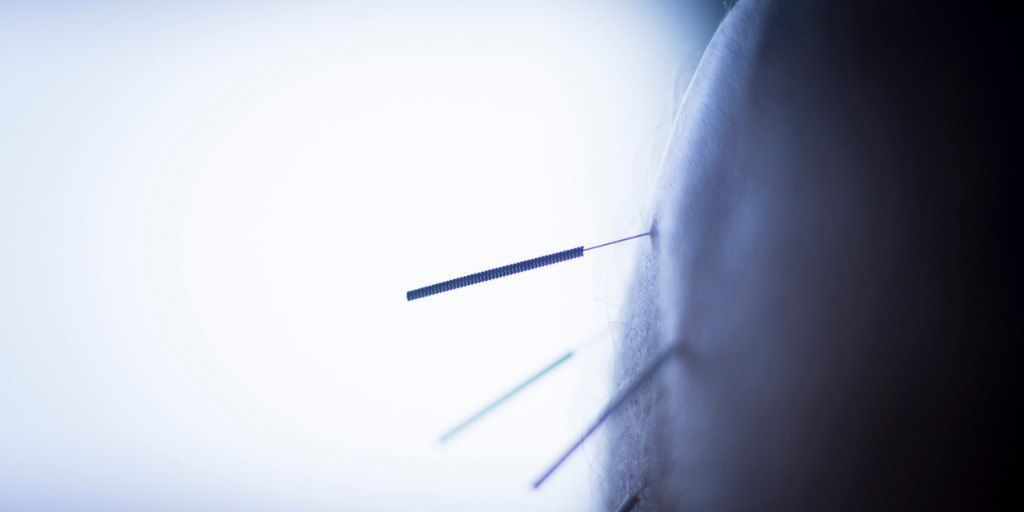August 29th, 2019 | 3 min. read

When it comes to most any activity involving needles, you are not going to get a lot of hands shooting into the air to volunteer. But, those who have experienced the benefits of dry needling therapy swear by it, and it’s not hard to see why. The technique offers nearly immediate relief from muscular pain with mild, if any, side effects.
Our friends at Richmond Physical Therapy helped us to compile this introduction to dry needling therapy.
Dry needling is one tool in physical therapist’s toolbox to reduce pain and improve range of motion. It’s a modern medical technique using a thin needle inserted directly into the muscle to relieve tension when massage and other therapies haven’t been effective.
Both practices use “dry” needles (meaning that the needle is solid and not used for injecting medicine) inserted under the skin. They may appear similar, but they are different practices with different goals.
Acupuncture is rooted in traditional Chinese medicine and has been practiced for thousands of years. The goal of acupuncture is to open up a person’s energy flow by stimulating certain points along the body’s meridians.
Dry needling, by contrast, is a modern treatment used in Western medicine to ease muscular and/or neural pain and improve range of motion. In order to become certified in dry needling in the state of Virginia, practitioners must complete at least 54 hours of post-professional training.
Dry needling can be used to treat trigger points, which are hypersensitive bands within muscle tissue that are constantly contracting and can cause pain or limit range of motion. Commonly found in your neck or back, trigger points are those hard, painful knots that just won’t let go. They can be caused by repetitive motion, injury, or chronic stress.
If chronic stress is causing muscular pain or other concerns, check out this article with 3 Ways to Overcome Stress. It offers practical advice for better managing day-to-day stress from Dr. David Pong.
Dry needling often produces a twitch response in the trigger point that helps the muscle to relax, releasing tension, improving range of motion and reducing pain.
There are both biochemical and mechanical effects produced from dry needling. Research suggests that the biochemical effect reduces the pain signals to and from the brain, while the mechanical effect creates localized micro-trauma, bringing healing chemicals to the site.
There are also specific techniques employed with dry needling to elicit a targeted response.
Numerous studies have confirmed the effectiveness of dry needling for treating acute and chronic pain. When performed correctly by a trained medical professional, the procedure is relatively simple, noninvasive, and low-risk. Overall, dry needling therapy works best when combined with other physical therapy tools.
Common ailments that could be helped by dry needling include:
When the needle is inserted, you may feel a sensation of pressure in the muscle. If the muscle twitches, then you may feel a brief “jumping” sensation in that area. While the needles are “in situ,” you may feel a deep ache in the muscle that usually gradually subsides. There may be some soreness after treatment, similar to after a workout or massage. Occasionally, light bruising can occur in the muscle, but typically clears up after a day or two.
As always, talk with your doctor about your options for treating muscular pain. If dry needling makes sense for you, you’ll need a referral as the procedure breaks the skin and is considered invasive. Dry needling is typically not covered but insurance, but be sure to check the details of your specific policy. When you’re ready to choose a practitioner, be sure to look for a licensed physical therapist or medical care professionals that has been certified in dry needling therapy.
Download our free guide to exercise, healthy eating, improved sleep quality, and better stress management.
As a board-certified family medicine physician at PartnerMD in Richmond, VA, Dr. James Bampton is dedicated to helping you with various health issues throughout life. He provides personalized, preventive care focusing on patient relationships and comprehensive treatment. Dr. Bampton views his relationship with you as a partnership, ensuring your health needs are met with individualized attention.
Topics: